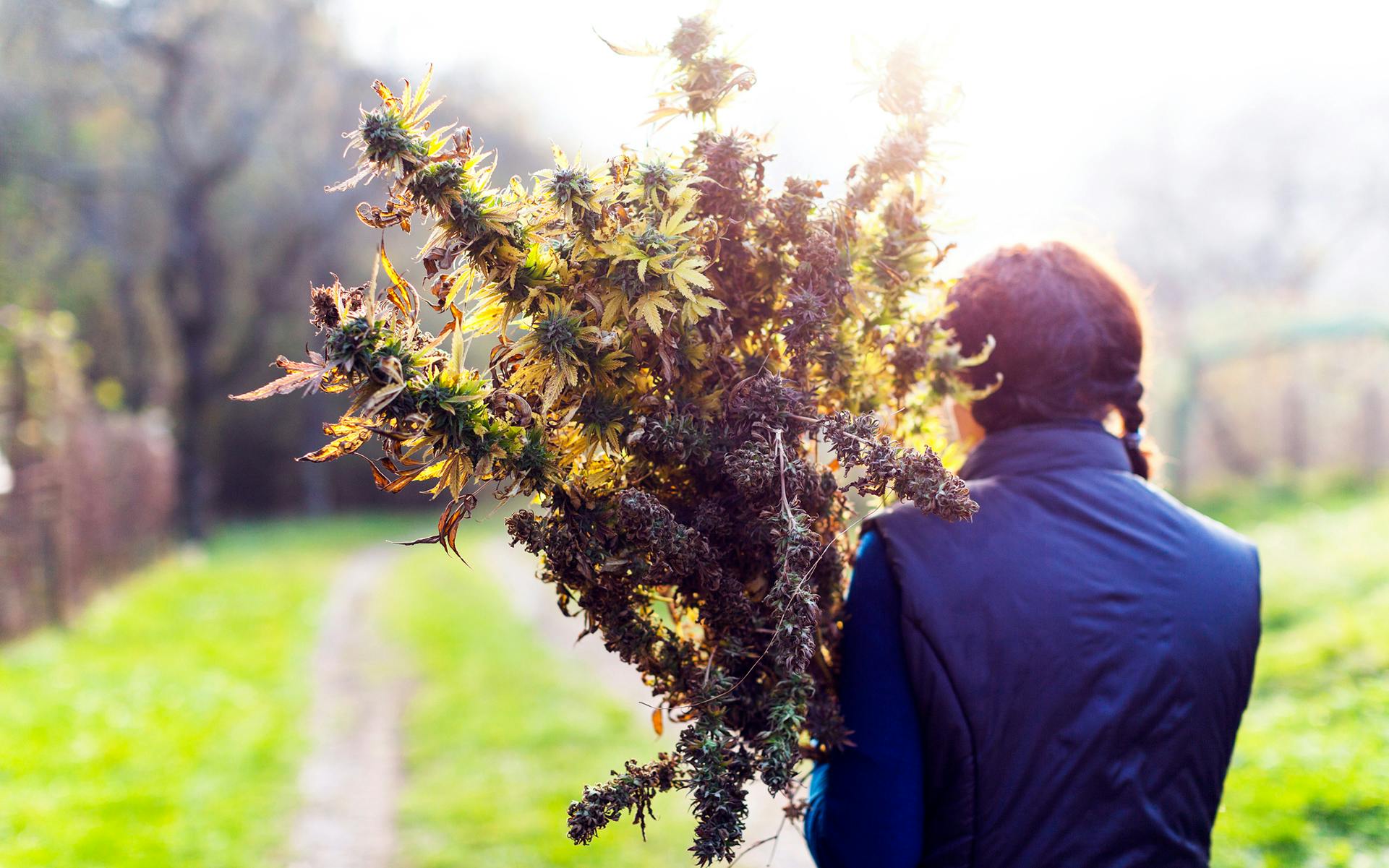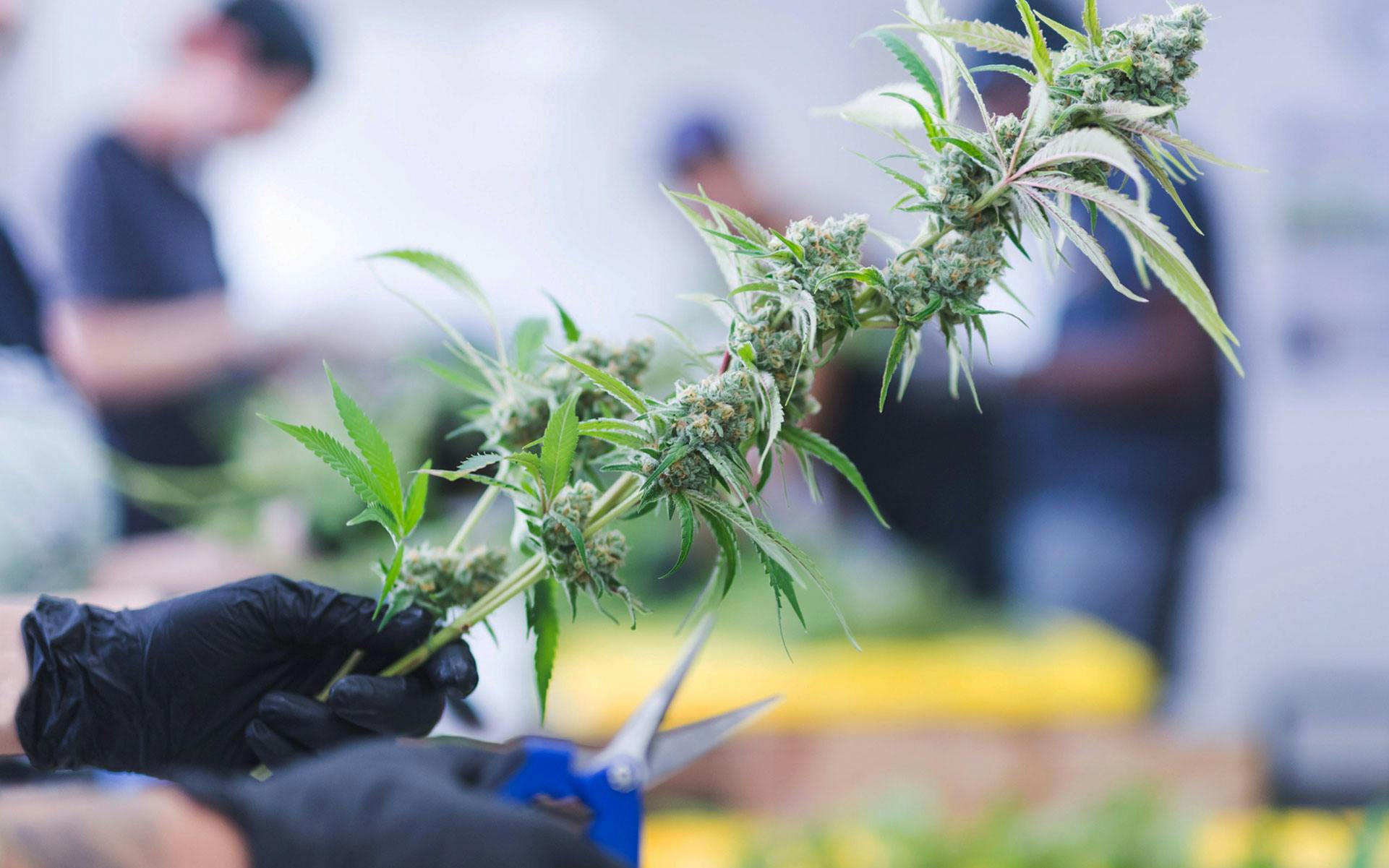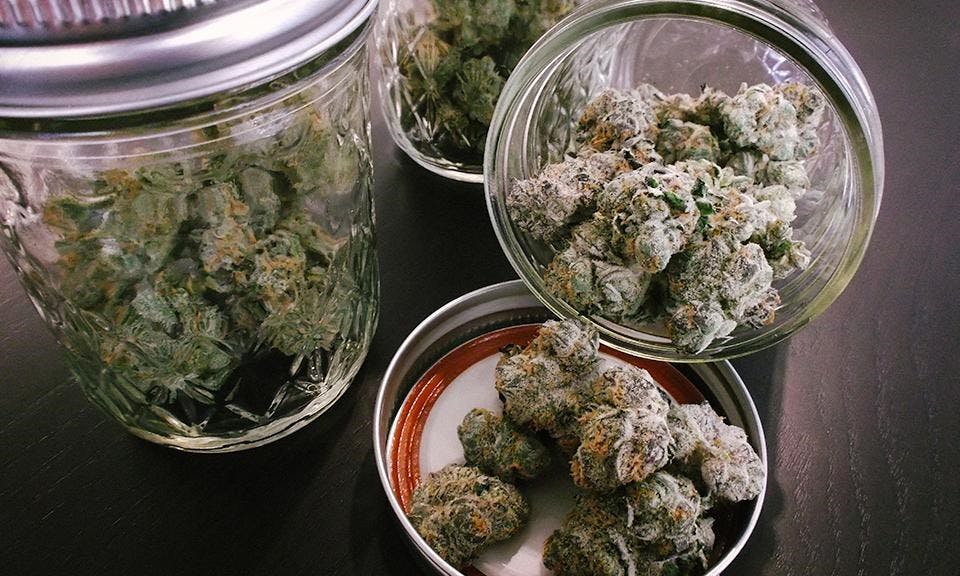
Like all plants, cannabis requires water in order to perform its basic functions. Water helps plants absorb nutrients from the soil and then moves up the plant and into the leaves, and without it, the plant can’t survive. But giving a marijuana plant the proper amount of water may be more difficult than you think.
There isn’t an exact science for watering a weed plant. You can’t observe the roots in most cases to see if they need water. Also, a plant is constantly growing and the climate it’s in will fluctuate, so the amount of water it needs constantly changes.
Here are some tried-and-true tips to keep your weed plants healthy and properly hydrated.
How often should you water marijuana plants?
A common mistake first-time growers make is to overwater marijuana plants. A cycle of wet and dry is healthy and necessary for the roots of a plant to grow out and reach deeper into the soil.
Additionally, roots pull in oxygen as soil dries and when soil is too wet, the plant can’t pull in oxygen efficiently and essentially can’t breathe.
Below are general estimates and are meant to give growers a rough sense of frequency of waterings; if a plant needs water and it falls outside of these ranges, water it.
Marijuana watering schedule by plant stage
| Plant stage | Water every # of days |
| Germination | 4-7 |
| Seedling | 3-7 |
| Vegetative | 2-4 |
| Flowering | 2-3 |
How to tell if a cannabis plant needs watering
The best ways to tell if a weed plant needs water is to:
- Stick a finger 1-2 inches into the soil—if it’s wet, hold off; if it’s dry, it’s time to water.
- You can also pick up a pot and feel its weight to determine if it needs water. This will take some experience—be sure to lift up your pots after watering to get a feel for how heavy they are when full of water. This will also give you a sense of what a light, dry, plant feels like.
An under-watered marijuana plant looks droopy and weak, with yellow or brown leaves; there is no strength in the leaves and they look lifeless.
Leaves of an overwatered plant look slightly similar in that they droop, except the leaves will be dark green and the leaf tips will be curled.
Note how often you water plants and write it down in a log. Get your marijuana plants on a watering schedule—as they grow out of the seedling stage, watering every two to three days is ideal.
Shop highly rated dispensaries near you
Showing you dispensaries nearKeep in mind that as plants get bigger, they will need more water and need to be watered more frequently.
When growing weed outdoors, you’ll need to water more often as the weather gets hotter and less often as it cools.
When you find the sweet spot between too wet and too dry, your plants will flourish.
Best time of day to water weed plants
Weed plants retain water better at cool, moderate temperatures. In warm months, it’s best to water plants early in the morning before the sun is high in the sky, and late in the evening, when the sun is on its way down. In cold months, water during the day and not at night, as cold water can stress the root system.
How much should you water marijuana plants?
The amount of water your marijuana plants need depends on a few factors:
- Size of plant
- Outside temperature
- Overall health
- Stage of growth
How much water do weed plants need?
You want to water a plant enough to soak all the soil in the pot. Water should pool up on the surface of the soil when you’re watering, and come out the drainage holes in the bottom of the pot after a couple seconds. If water sits on the surface of the soil, that means it’s too wet and doesn’t need more water.
If a weed plant is very dry, water will run straight through the soil and pot and quickly come out the drainage holes. If this happens, water the plant a little bit and then come back to it after 15-20 minutes and water it again, and maybe even a third time. This allows the soil to slowly absorb water until all of it is thoroughly wet.
Roots are constantly on the hunt for water as they grow and stretch out. As a plant gets bigger, so should the watering radius—the area around the stalk of the plant that you water. Doing this will help guide roots to the edges of the pot as they seek available nutrients in soil.
Watering too far away from the roots can create standing water, which can lead to root rot, mold, and pest issues.
Is your container the right size?
To properly water a cannabis plant, it needs to be in the correct size container, or a big enough hole if it’s in the ground. If a pot is too big, the plant’s roots can’t drink water where they don’t reach. If the roots aren’t absorbing water, water will sit in soil and take a long time to evaporate, which can promote root rot and unwanted insects and fungus.
Conversely, if a container is too small, the roots won’t be able to stretch out, which can stunt the growth of a plant. Less soil also means you’ll need to water the plant all the time, which will add labor.
Ideally, cannabis plants should start in a small pot and progress to bigger and bigger pots as they outgrow each container. For example, you can start a seedling or clone in a 4″ or 1-gallon pot, then move on to a 2-gallon, 5-gallon, 10-gallon, and so on.
Plants are ready to transplant when a healthy root structure encompasses most of the soil and the roots aren’t bound. When transplanting, take time to look at the quality of the roots: Bright white roots with a strong, thick structure is a sign plants are getting watered correctly.
Check out more info on when to transplant here.
What is flushing?

Flushing is an important part of the marijuana growing process, when you stop giving a marijuana plant nutrients and give it straight water. This is done to flush out nutrients that may have built up in a plant during its life.
Flushing is done for about a week before harvest, at the end of a plant’s flowering stage when buds are almost ready to cut down.
A flush can also be done to clear plants of nutrients if they have a nutrient imbalance, such as nutrient lockout, when your plants are overloaded with nutrients and unable to absorb new ones.
How to flush weed plants
Flushing marijuana plants before harvest
The final flush should occur for a week or so before you cut down weed plants for harvesting. Water your plants with the same amount as you normally would, but only with water. This will force the plant to use the nutrients stored within it—if its nutrient reserves are not used or broken down, it could affect the quality of your harvested buds.
By looking at the trichomes on marijuana plants, you’ll be able to tell when the plants are ready for a flush—begin when they start turning milky.
Different growing mediums require different flushing timeframes before harvest:
- Soil: 7-10 days
- Rockwool and coco: 7 days
- Hydroponics: 5-7 days
If growing in amended organic soil, it is not recommended to flush plants. This is because the soil already holds all the nutrients the plant needs to thrive, and by flooding the soil you can wash away and damage the complex ecosystem that you’ve worked hard to develop.
When to stop watering before harvest
Water your marijuana plants as normal when in the flushing phase—don’t let them get too dry or too wet. Make sure not to harvest dry or wilting weed plants—they should be nice and healthy when you cut them down.
Flushing marijuana plants for nutrient imbalance or lockout
Weed plants with too many nutrients, improper pH levels, or other stresses can result in a nutrient imbalance or lockout. Nutrient lockout results from a buildup of nutrients or salt in the soil, preventing absorption of new nutrients.
Flushing plants will remove this excess buildup and help restore the soil’s pH level. This will allow plants to resume absorbing nutrients to grow at a healthy, successful rate.
To perform this type of flush, excessively water your plants with water at a pH level between 6.0-6.8 for soil and 5.5-6.5 for hydroponics. Fully saturate your pots, and repeat 15 minutes later. The flush should clear any blockage and make room for new nutrients.
How to source the best water for marijuana plants

To grow healthy, strong cannabis plants, you need clean water.
There are two common misconceptions when it comes to water for cannabis plants:
- All water is the same
- Water deemed safe for consumption will also be adequate for plants
Water can contain a number of contaminants, some of which are safe to be used in a garden and some that can have serious consequences for a plant’s health. Every grower should know where to source clean water and how to treat contaminated water to make it suitable for a garden.
Know Your pH and PPM
One factor of water quality is its pH level, or potential hydrogen level. This measures the acidity and alkalinity of a given fluid and occurs on a scale of 0 (most acidic) to 14 (most alkaline).
Examples of highly acidic fluids include battery acid, lemon juice, and vinegar, while highly basic fluids include household ammonia and bleach. Distilled water is neutral with a pH of 7.
Depending on the grow medium you’re using—soil, rockwool, hydroponics, etc.—cannabis prefers its water to be in the 6-7 pH range, which is optimal for nutrient uptake.
Another factor of water quality is ppm, or parts per million. This measures the presence of dissolved solids in water. Because most water isn’t pure H2O, ppm gives a measurement of the percentage of contaminants in a given water source.
Contaminants found in water sources can include:
- Chemical: chlorine, chloramine, magnesium, calcium, salts, nitrogen
- Physical: rocks, sand, sediment, organic material
- Biological: bacteria, mycotoxins, viruses, parasites
- Radiological: uranium, cesium
Many water sources naturally have contaminants. Streams, ponds, and lakes can contain a range of biological contaminants like bacteria and parasites.
Other water sources, such as treated municipal water, or tap water, is often treated with some amount of chemicals like chlorine, calcium, and magnesium, in order to get rid of the possibility of biological growth.
Water that contains higher quantities of minerals such as calcium or magnesium is called hard water. This type of water has a higher ppm due to the extra dissolved solids in it.
Water with less minerals and a lower ppm is called soft water.
Where to source water for your cannabis garden
Cannabis homegrowers have several options available at various price points when sourcing water for a garden, each with its pros and cons.
Factors to keep in mind when looking at water sourcing options include:
- Total cost upfront vs. cost accrued over time
- Availability of water
- Overall water quality
- How difficult it is to scale or increase the amount of water needed
- Labor needed to bring in water
- Environmental impact
The options below represent the most practical water sourcing methods available to the average homegrower, but keep in mind that other sources are available.
Unfiltered tap water
Contrary to popular belief, using unfiltered tap water on cannabis is not a death sentence for plants. This type of water varies greatly depending on the municipality and its water treatment protocols.
Some cities use incredibly hard water with high levels of contaminants such as chlorine, calcium, and magnesium. While water with a low ppm concentration of these chemicals won’t necessarily kill a plant, it can have a negative impact on the biological activity in organic soil.
One trick to rid water of chlorine is to let your water sit out for 24-48 hours. Doing so will allow ample time for chemicals to evaporate, making tap water usable for growing.
Pros
Tap water is inexpensive, meaning it’s easy to scale. Also, there’s little labor involved in using tap water after the ppm and pH are adjusted.
Cons
This option may not be available for growers living in cities with heavily treated water systems. Organic growers will also find that chemicals in treated water may have a negative impact on biological life in soil.
Water collection systems
You can create a system to collect rainwater or gray water. These systems work very well under the right circumstances and can be both inexpensive and environmentally friendly.
Pros
Water collection systems, such as rainwater and gray water catches, can last for long periods of time with little maintenance and can be scaled for any size garden. Systems like this are especially useful in climates with dry periods where water saving is encouraged.
Cons
Unfortunately, many jurisdictions have ordinances that either completely prohibit or set strict limits on the collection of rainwater and the reuse of gray water. Proponents of these restrictions argue that there are health and safety concerns.
Although setting up a simple water catching system can be inexpensive, there is still some start-up capital required. Water that has been collected either by rain or by reuse will also need to be filtered and stored properly, requiring filter systems and specially graded storage containers built to withstand the elements without risk of contamination or breaking.
Bottled water
Bottled water is a great pure, uncontaminated source that’s relatively inexpensive for a small-scale garden. Most grocery stores and shopping centers have bottled distilled water and many companies offer water delivery services at reasonable prices.
Pros
This water is affordable in low quantities and easy to source. It’s also safe for plants and doesn’t need any extra filtration.
Cons
There is a certain amount of labor involved in retrieving bottled water.
Bottled water also has a big negative impact on the environment, in the resources needed to create containers for the water and resources needed to transport the water, such as fuel. Trash is also a consideration with water containers.
Reverse osmosis (RO) systems
For large-scale marijuana growers with less financial restrictions, water filtration systems are the go-to option for an unlimited supply of clean water. There are several effective filtration systems available, though reverse osmosis (RO) systems seem to be the most popular for cannabis cultivators.
These systems work by pushing water molecules through a semi-permeable membrane, filtering out most contaminates. There are many varieties of RO systems that vary greatly in price.
Pros
Using an RO system will ensure absolute filtration and decontamination, making it a safe method for cleaning large quantities of water for a grow operation. After initial installation costs, this system will supply a virtually endless supply of clean water for a grow.
Cons
The initial cost upfront for even the most basic RO system can be hundreds of dollars, with more advanced systems stretching into the thousands. With such a high barrier-to-entry, small-scale growers may find that this system is a pipe dream.
RO systems are also known to waste quite a bit of water, making them high on the list for negative environmental impact. RO systems continue to draw and filter water for a period of time after use, thus wasting water. By installing a permeate pump, you can reduce the amount of water wasted.
Patrick Bennett and Trevor Hennings contributed to this article.
Read more of Leafly’s guide to growing marijuana
- How to grow weed: Basics of growing marijuana
- 4 stages of marijuana plant growth
- Marijuana plant anatomy
- How to grow weed indoors
- How to grow marijuana outdoors
- Cannabis seeds 101: How to grow marijuana from seed
- How to clone cannabis plants
- Marijuana seedling and plant care
- How to harvest marijuana plants
- Troubleshooting common cannabis plant problems
- Buyer’s guides for cannabis seeds and growing equipment
- How to grow marijuana using hydroponics, aeroponics, or aquaponics
Ready to start growing your own marijuana?
By providing us with your email address, you agree to Leafly's Terms of Service and Privacy Policy.


